Lancaster Corporation Tramways
History
Lancaster's standard-gauge, overhead electric tramway system commenced operation on the 14th January 1903.
The system was very small by municipal standards, a mere 2.99 miles. It comprised lines from Dalton Square in the centre of the city: southwards to Scotforth, with another line branching off southeastwards along Bowerham Rd to Bowerham, where it turned northwestwards to terminate at Williamson Park; and westwards to the London and North Western Railway Company's Castle Street Station.
It is highly doubtful that such a small system could ever have been made to pay, which is almost certainly why the corporation opened negotiations as early as 1900 with the Lancaster and District Tramways Company — whose horse tramway terminus in Stonewell was barely 200 yards from Dalton Square — to purchase their undertaking, no doubt with conversion to electric traction in mind. Agreement could however not be reached, the tracks of the two tramways remaining unconnected for their entire existence.
The financial travails of the tramway became apparent very quickly, small but continual losses being suffered throughout the Edwardian era, a period during which all bar a handful of tramways in the entire country were making money. The fact that the LCT could not make a profit during the heyday of the electric tramway boded ill for the less congenial times that were just around the corner. The financial situation also put paid to any thoughts of extensions, which left large swathes of potential passengers unserved by the system. In fact, the need to service new munitions works during the Great War led to the LCT introducing battery-electric buses (in 1916) rather than extending the trams, a technology hardly suited to the hilly terrain of Lancaster, though they did somehow manage to struggle on into the early 1920s.
Like most tramway systems, Lancaster's emerged from the rigours of the Great War — lack of maintenance and investment, and higher loadings — into a post-war world of greatly increased costs and inflationary pressures. The tramway continued to run at a loss, a situation which led to increasingly desperate cost saving measures, including one-man operation, all of which failed to remedy the financial situation.
The spectre of expensive track renewal on the Castle Station line led to a decision to close it, and by April 1922, the lines were in the process of being lifted. The corporation was also looking to the future, branching out into bus operation, the first vehicle being put into service towards the end of 1924. A handful of others soon followed, and these no doubt abstracted yet more passengers from the increasingly dilapidated trams.
By 1928, the writing was clearly on the wall, and in September of that year, the Tramways Sub-Committee decided to abandon the remaining lines and replace them by buses. The trams struggled on for another 20 months, the last service of all running on the 4th April 1930.
Uniforms
Early photos suggest that motormen and conductors were issued with double-breasted, 'lancer-style' tunics with five pairs of buttons (narrowing from top to bottom, and bearing the full system title and municipal device — see link) and upright collars; the latter carried an employee number — in individual metal numerals — on the bearer's left-hand side, and the system initials — 'L C T' — on the right-hand side (in individual metal letters). Later photos frequently show conductors, as well as the odd motorman, wearing single-breasted jackets with five buttons and upright collars, suggesting that these became the standard issue, though it appears to have been far from rigorously applied.
Caps were initially in a kepi style with a glossy peak and carried a small municipal shield badge, which was worn above a script-lettering grade badge, either Conductor or Motorman; these were probably brass to match the buttons (see link). At some point, probably within the first five years of operation, the kepis were replaced with more modern, military-style caps with tensioned crowns (tops); the insignia however, remained unchanged.
Tramcar staff were also issued with long, double-breasted greatcoats with five pairs of buttons and high, fold-over collars. The latter appear to have carried the same insignia as the tunics/jackets worn underneath, but in later years, these were frequently left plain (i.e., without badges of any kind). Conductors and motormen also wore a round municipal licence — possibly brass, bearing a large number in the middle — which was hung by a leather strap from a tunic button on the bearer's left breast. In later years, it is possible that this was replaced by an alloy pattern (see below), though evidence to support this is currently lacking.
Inspectors wore typical tramway inspector garb, namely, a single-breasted jacket with hidden buttons (or an hook and eye affair), with two breast pockets and upright collars, the latter bearing LCT on the bearer's left-hand side, and Inspector on the right-hand side, both in embroidered script lettering. The pockets and edges of the jackets were finished in a finer material than the main body, the same material being used to embellish the sleeves with chevrons. Caps were probably in a kepi-style initially, but were certainly changed to a military style, probably at the same time as the tramcar staff; they bore the grade — Inspector — in embroidered script-lettering on a hat band, above which, the standard municipal shield badge was worn.
Many tramway systems employed women during the Great War to replace male staff lost to the armed services, however, it is currently unclear whether Lancaster Corporation Tramways did likewise.
Further reading
For a history of Lancaster's tramways, see: 'The Lancaster and Morecambe Tramways' by S Shuttleworth; Oakwood Press (1976).
Images
Motormen and conductors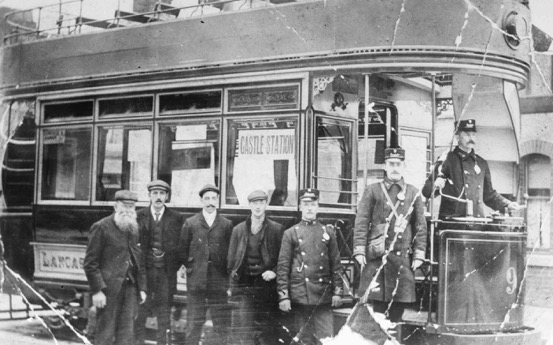
An early photo of three Lancaster tramcar staff with Tramcar No 9 — photo undated, but probably taken shortly after opening in 1903 or 1904. Photo courtesy of the National Tramway Museum. 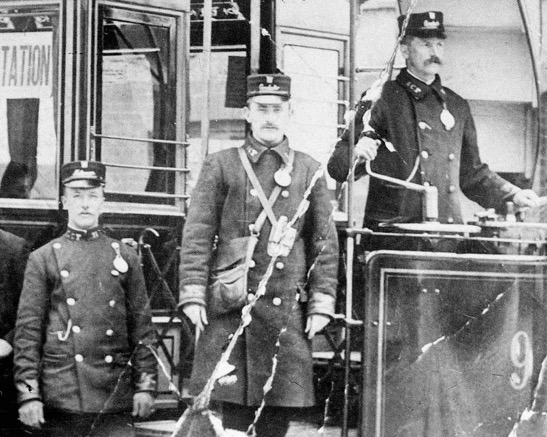
A blow-up of the above photo showing the three tramcar staff; all are wearing kepi-style caps bearing script-lettering grade badges and a small municipal shield badge. Each of the men also has a round licence suspended on a leather strap.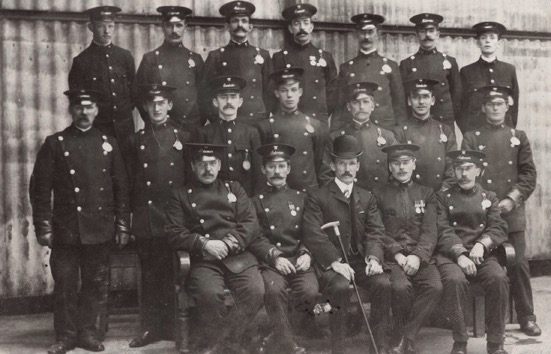
Staff photo, very probably taken outside the tram shed in Thurnham Street; although undated, it looks to be late Edwardian, and a surviving postcard is date stamped 1st October 1912, so it was certainly taken no later than this. The motorman on the extreme left is probably Bill Gates (see later photo). By this time, the earlier kepi-style caps had clearly been replaced by military-style caps with tensioned crowns (tops). Several of those present are wearing military medals, suggestive of Boer War service. Author's Collection.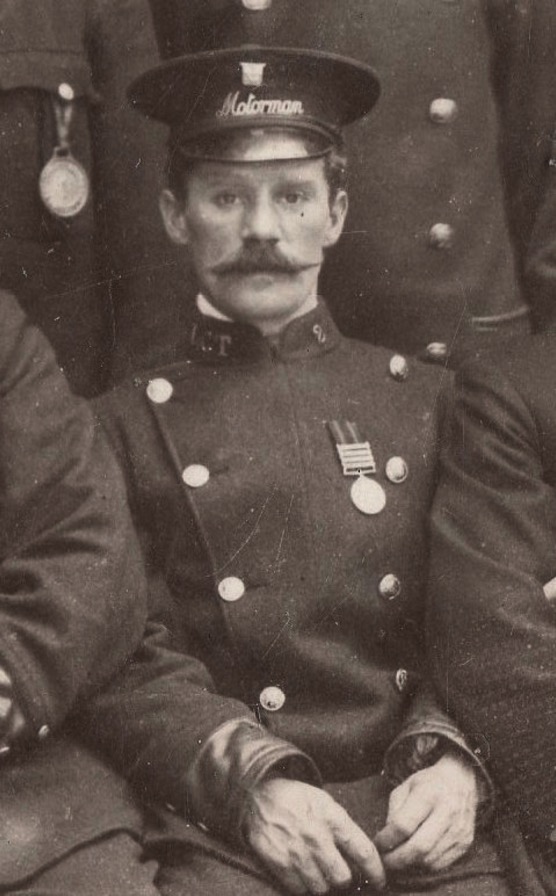
A blow-up of the preceding staff photo showing employee No 2, a motorman, in double-breasted, 'lancer-style' tunic. The collar insignia, script-lettering grade badge (on the cap) and municipal shield badge are all easily made out. Although the individual depicted is not wearing a municipal licence, one of the men behind him is, and the photo is clear enough to discern a large numeral in the centre of the badge.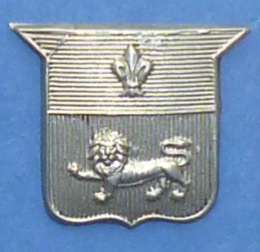
Lancaster Corporation Tramways cap badge — nickel. It is unclear what material was actually used, though it was probably brass given that surviving buttons are of this material. This particularly example would have been used by another municipal department. Author's Collection.
General pattern script-lettering cap badges — Motorman and Conductor — of the type used by Lancaster Corporation Tramways.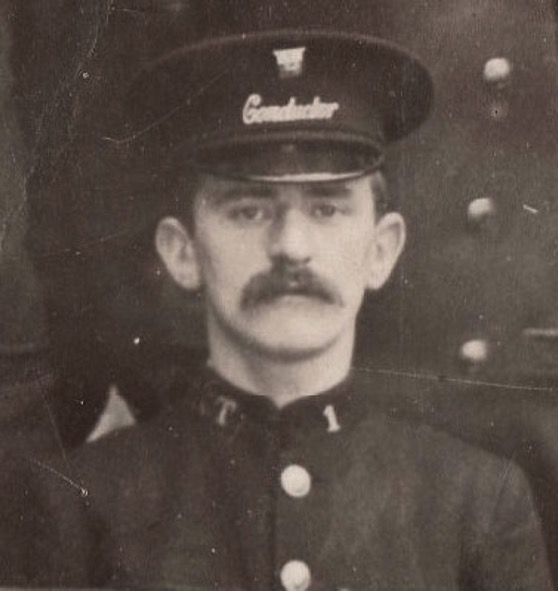
Another blow-up of the staff photo above, this time showing a conductor (Employee No 1), one of three individuals in single-breasted jackets rather than the usual 'lancer-style' tunics.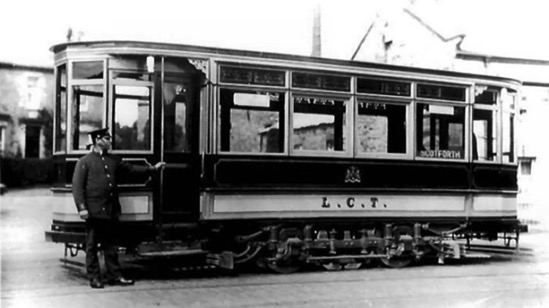
One-man operated car — photo undated, but probably taken in the early 1920s. Photo courtesy of Duncan Holden.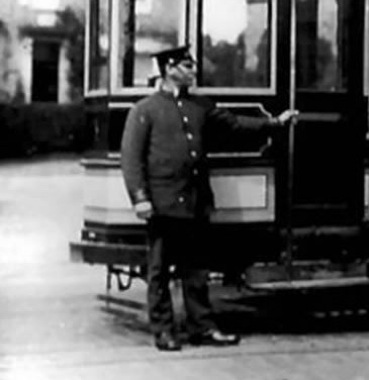
A blow-up of the above photo showing the motorman, in single-breasted jacket. 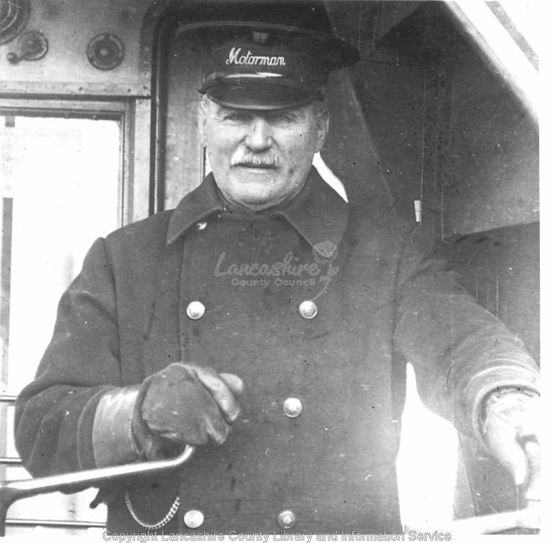
Motorman William Gates at the controls of an unknown tram, probably taken at the Scotforth Terminus in 1927. With thanks to Lancashire Libraries.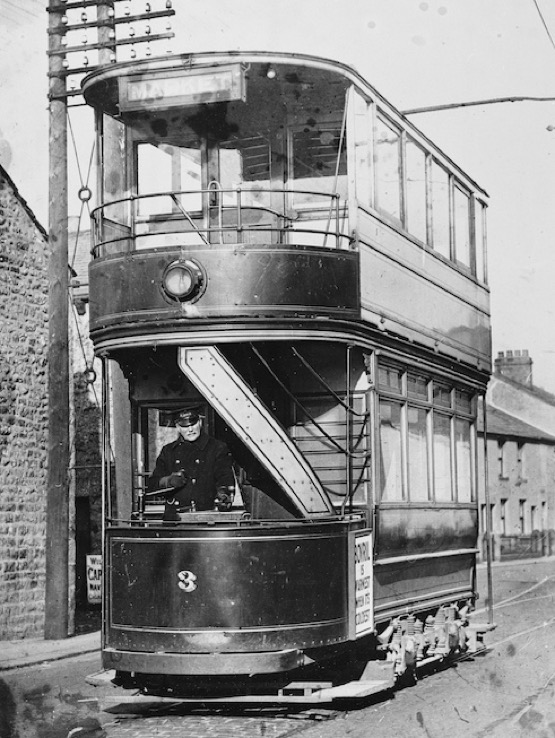
Another shot which was probably taken in 1927 at the Scotforth terminus, again Motorman William Gates, this time at the controls of Tram No 3. Photo courtesy of the National Tramway Museum. 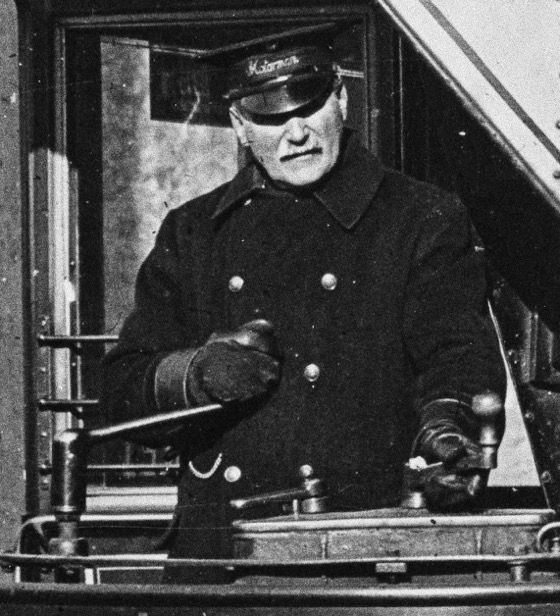
A blow-up of the above photo show Motorman Gates.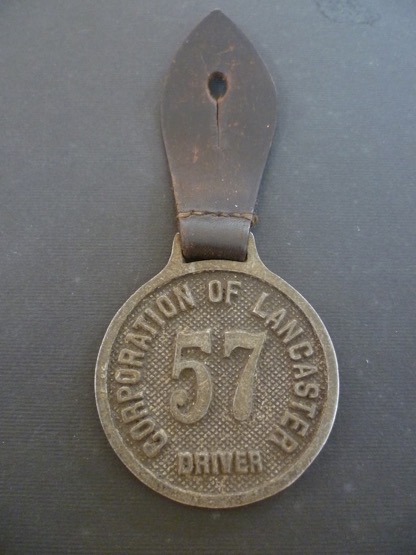
Lancaster Corporation driver's licence No 57 — alloy. Whilst this licence is definitely not the pattern used during the early years of the tramway (see staff photo above) there is a possibility that it was worn during the last few years of the tramway's existence. Author's Collection.
Senior staff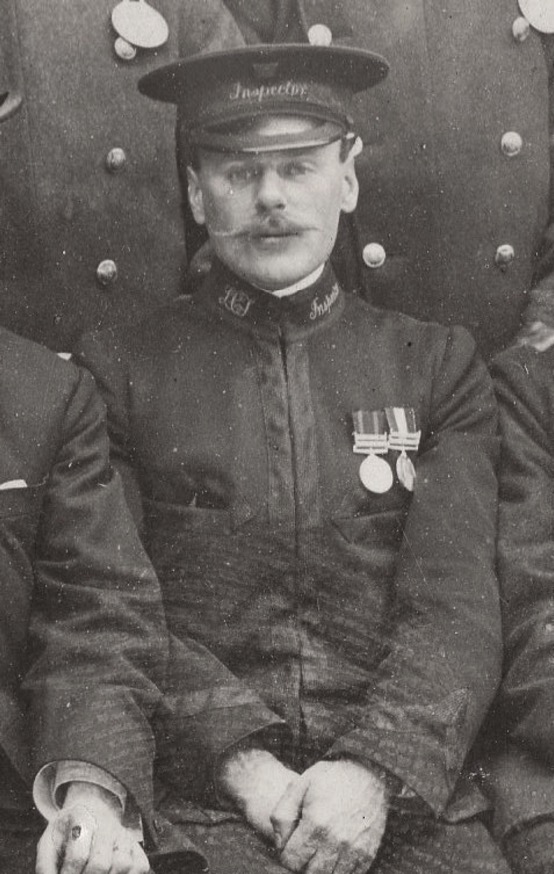
A blow-up of the staff photo above showing the inspector. The embroidered collar and cap badges are clearly seen, as are the jacket embellishments, including the sleeve chevrons.